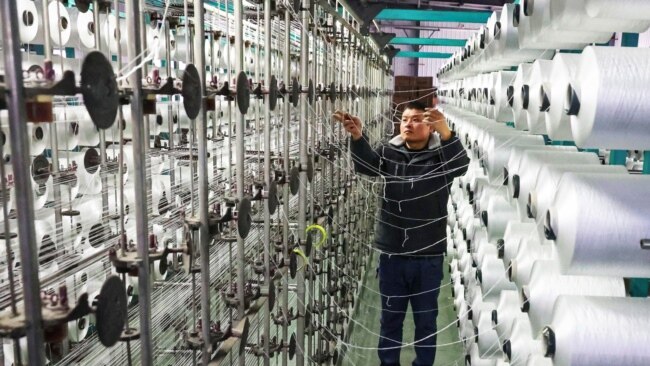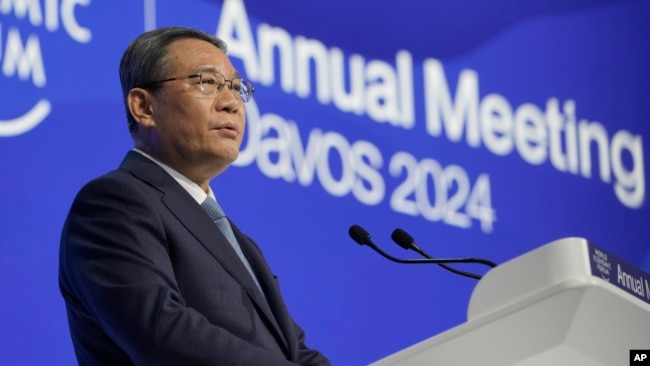우울한 경제 데이터는 중국의 앞으로의 어려움을 암시합니다
Dreary Economic Data Suggests Struggles Ahead for China
페이지 정보
작성자 Rob Garver 작성일 24-01-18 01:32 댓글 0본문

파일 - 한 채용 담당자가 2023년 6월 9일 베이징의 한 쇼핑 센터에서 열린 채용 박람회 부스에서 한 지원자와 이야기를 나누고 있습니다. 높은 청년 실업률은 중국 경제가 여전히 어려움을 겪고 있다는 징후 중 하나입니다.
FILE - A recruiter talks with an applicant at a booth at a job fair at a shopping center in Beijing, on June 9, 2023. High youth unemployment is one sign that China's economy is still struggling.
중국 정부가 수요일 발표한 각종 경제 지표는 중앙 정부가 제시한 완만한 성장 목표를 넘어섰음에도 불구하고 코로나19 팬데믹 속에서 여전히 제자리 찾기에 어려움을 겪고 있는 경제의 모습을 보여줍니다.
A flurry of economic indicators released by the Chinese government on Wednesday paints a picture of an economy that is still struggling to find its footing in the wake of the COVID-19 pandemic, even though it exceeded the modest growth target set by the central government.
국가통계국에 따르면, 중국 경제는 2023년에 5.2% 성장했습니다. 그러나 그 소식과 함께 중국은 여전히 지속적인 디플레이션, 부동산 시장의 지속적인 위기, 높은 청년 실업 및 장기적인 인구 감소로 고통 받고 있다는 증거가 나왔습니다.
According to the National Bureau of Statistics, the Chinese economy grew 5.2% in 2023. But with that news came evidence the country is still suffering from persistent deflation, an ongoing crisis in its real estate market, high youth unemployment and long-term population decline.
중국의 수출이 2023년에 4.6% 감소했다는 보고서가 나온 지 며칠 만에 경제 데이터가 발표됐는데, 이는 2016년 이후 처음으로 전년 대비 감소한 것입니다.
The economic data was released just days after a report revealed that China’s exports had decreased by 4.6% in 2023, the first year-on-year decline since 2016.

참고 항목: 중국은 1990년 이래 최악의 성장을 기록했습니다
SEE ALSO:
China Sees One of Worst Years of Growth Since 1990
정부는 "국가 경제가 회복의 모멘텀을 목격하고 수급이 꾸준히 개선되었으며, 변혁과 업그레이드가 견조하게 진전되었으며, 고용과 물가가 전반적으로 안정되었으며, 국민의 안녕이 견고하고 효과적으로 보장되었으며, 양질의 발전을 추구하는 데 꾸준한 진전이 있었고, 주요 기대 목표가 잘 달성되었다"고 보고하며 긍정적인 데이터를 시도했습니다
The government attempted to put a positive spin on the data, reporting that “the national economy witnessed the momentum of recovery, supply and demand improved steadily, transformation and upgrades were advanced solidly, employment and prices were generally stable, people’s well-being was robustly and effectively guaranteed, steady progress was made in pursuing high-quality development, and major expected targets were well achieved.”
하지만 금융 시장은 확신하지 못했습니다. 수요일 중국 기업을 추적하는 주요 주가 지수는 급락했고, 항셍 중국 기업 지수는 4% 가까이 떨어졌습니다. 지수는 2023년 말 이후 11%, 전년 대비 27% 하락했습니다.
However, financial markets were not convinced. Major stock indices tracking Chinese firms plummeted on Wednesday, with the Hang Seng China Enterprises Index shedding nearly 4%. The index is down 11% since the end of 2023 and 27% year-over-year.
목표가 낮음
Low target
자료 발표 전날, 리창 중국 총리는 스위스 다보스에서 열린 세계경제포럼에서 발언을 통해 2023년 정부의 성장 목표치인 약 5%를 초과 달성했다고 발표했습니다. 하지만, 전문가들은 VOA에 정부가 이 기준을 매우 쉽게 통과시켰다고 말했습니다.
The day before the release of the data, Chinese Premier Li Qiang used remarks at the World Economic Forum in Davos, Switzerland, to announce that the government’s growth target of about 5% had been exceeded in 2023. However, experts told VOA that the government had made the bar very easy to clear.

리창 중국 총리가 1월 스위스 다보스에서 열린 세계경제포럼 연차총회 참석자들에게 연설하고 있습니다
Premier of China Li Qiang addresses attendees of the Annual Meeting of World Economic Forum in Davos, Switzerland, Jan. 16, 2024.
Peterson Institute for International Economics의 연구원이자 중국 프로그램 코디네이터인 Tianlei Huang은 VOA에 말했습니다. 그는 2021년까지만 해도 중국 경제가 8% 이상 성장하고 있었다고 지적했습니다.
“That was a low target to begin with,” Tianlei Huang, a research fellow and China program coordinator at the Peterson Institute for International Economics, told VOA. As recently as 2021, he noted, the country’s economy was growing at above 8%.
경제학자들은 중국이 올해 2023년 수준의 성장을 유지하는 데 어려움을 겪을 것으로 보고 있습니다. 예를 들어, 세계 은행의 최근 예측에 따르면 중국 경제 성장률은 2024년 4.5%로 둔화됩니다.
Economists believe China will have difficulty sustaining 2023’s level of growth this year. The World Bank’s latest projection, for example, has Chinese economic growth slowing to 4.5% in 2024.
고무적인 징후들이 몇 가지 있었다고 Huang씨는 말했습니다. 예를 들어, 소매판매는 가계의 가처분 소득보다 높은 비율로 증가했습니다. 하지만, 가계의 소비지출을 보다 더 잘 파악할 수 있는, 가계의 서비스 소비에 관한 연간 데이터는 빠져 있었습니다.
There were some encouraging signs, Huang said. Retail sales, for example, grew at a rate higher than household disposable income. Missing, though, was full-year data on household consumption of services, which would give a fuller picture of household spending.
Huang은 또한 정부가 강력한 경제 발전을 하고 있다고 주장하지만, 중국 소비자들은 미래에 대해 확신하지 못한다는 것을 보여주는 증거도 있다고 말했습니다. 그는 상대적으로 수익성이 낮은 은행 예금 계좌에 돈을 넣는 비율이 증가함에 따라 심리가 명확해졌다고 말했습니다.
Huang said there also is evidence suggesting that despite the government’s insistence the country is making strong economic progress, Chinese consumers are not confident about the future. He said that sentiment was made clear by the rising rate of money being placed in relatively low-yield bank savings accounts.
"중국의 예금 금리가 하락하고 있기 때문에 이것은 특히 혼란스럽습니다."라고 Huang은 말했습니다. "따라서, 그들은 더 낮은 수익을 위해 은행 예금 계좌에 더 많은 돈을 넣고 있습니다. 그것은 가계가 여전히 걱정하고 있고 미래에 그들의 직업과 수입에 대해 걱정하고 있다는 사실을 반영합니다."
“This is especially puzzling, because depository [interest] rates in China are declining,” Huang said. “So, they're putting more money in bank savings accounts for lower returns. That reflects the fact that households are still concerned and are worried about their jobs and income in the future.”
디플레이션은 계속되고 있습니다
Deflation continues
수요일 발표된 자료에 따르면 12월 중국의 소비자 물가는 3개월 연속 하락했습니다. 소비를 촉진하고 물가를 끌어올리기 위한 중국 인민은행의 금리 인하에도 불구하고였습니다.
The data released Wednesday showed that in December, for the third consecutive month, consumer prices fell in China. This was despite an interest rate reduction by the People’s Bank of China, which was intended to spur consumption and drive up prices.

파일 - 12월 중국 남동부 푸젠성 샤먼에서 한 판매상이 기념품을 판매하고 있는 자신의 가게 밖에 앉아 있습니다
FILE - A vendor sits outside his store selling souvenirs in Xiamen in southeast China's Fujian province on Dec. 27, 2023.
소비자들에게는 긍정적인 발전처럼 보일지 모르지만, 지속적인 디플레이션은 기업들이 더 많은 재화와 서비스를 생산해야 하는 동기를 감소시키기 때문에 경제적으로 매우 해로울 수 있습니다. 그것은 결과적으로 경제 성장과 고용 수준에 부정적인 후속 효과를 가져옵니다.
While it may seem like a positive development for consumers, persistent deflation can be very damaging economically, as it reduces the incentive businesses have to produce more goods and services. That in turn has negative follow-on effects on economic growth and employment levels.
중국 정부가 수요를 늘리고 물가 하락을 억제하기 위해 경기 부양책을 내놓을지, 어떻게 내놓을지에 대해 엇갈린 신호를 보냈습니다. 지난 화요일, 블룸버그 통신은 중국 지도자들이 추가 부양책으로 1조 위안, 약 1390억 달러 규모의 채권을 발행할 가능성에 무게를 두고 있다고 보도했습니다.
The Chinese government has sent some mixed signals about whether and how it will provide economic stimulus to help increase demand and push back on price deflation. On Tuesday, Bloomberg reported that Chinese leaders are weighing the possibility of issuing bonds worth 1 trillion yuan, or about $139 billion, as additional stimulus.
부동산 고민
Real estate woes
중국의 부동산 시장은 심각한 재정난에 빠진 대형 개발업체들이 속출하고 부동산 가격도 폭락하는 등 고전을 면치 못하고 있습니다.
The property market in China continues to struggle, with a number of large development companies in significant financial distress and real property prices plummeting.
지난 1년 동안 몇몇 주요 부동산 개발 회사들은 채권 지불에 실패했고, 어떤 경우에는 채무 불이행에 빠졌습니다. 많은 경우 아파트를 위해 선불로 돈을 지불했던 고객들은 건설 프로젝트가 언제 다시 시작될지 전혀 알 수 없이 중단되는 것을 보았습니다. 이 위기는 일반 중국인들이 부동산 투자를 훨씬 더 꺼리게 만들었고, 상업용 부동산 부문에서도 그러한 꺼림칙함이 명백하게 드러났습니다.
In the past year, several major property development firms have fallen behind on bond payments and in some cases, have gone into default. In many instances, customers who had prepaid for apartments saw construction projects halted with no indication of when they would be restarted. The crisis has made ordinary Chinese much more reluctant to invest in real estate, and that reluctance has also been obvious in the commercial property sector.
전년 동기 대비 부동산 개발 투자는 9.6% 감소했습니다. 매매된 상업용 부동산의 총 제곱미터는 8.5% 감소한 반면 상업용 부동산 거래의 총 금전적 가치는 6.5% 감소했습니다.
Year-on-year, investment in real estate development declined by 9.6%. Total square meters of commercial real estate sold declined by 8.5%, while the total monetary value of commercial real estate transactions fell by 6.5%.
신규실업률
New unemployment figures
올해 초, 중국 정부가 지난 6월 중국 청년 실업률이 21% 이상으로 치솟았다고 발표한 뒤, 중국 정부는 자료 공개를 중단했습니다. 당시 정부는 자료 수집과 측정 관행을 개선할 필요가 있다고 밝혔습니다.
Earlier this year, after the Chinese government reported that unemployment rates among young Chinese had soared to more than 21% in June, Beijing discontinued its disclosure of the data. At the time, the government said it needed to improve its data collection and measurement practices.
청년 실업률은 수요일 보고서에 다시 나타나 6개월 전보다 현저히 낮은 14.9%를 기록했습니다.
Youth unemployment numbers reappeared in Wednesday’s report and were markedly lower than they had been six months previously, at 14.9%.
감소의 적어도 일부는 정부가 추적하기로 선택한 데이터의 종류에 의해 주도되었습니다. 과거에는, 아르바이트를 구했지만 찾을 수 없었던 학생들이 실업자에 포함되었습니다. 이제, 학교에 다니지 않는 개인들, 또는 이미 졸업한 사람들만 실업자로 계산됩니다.
At least part of the decline was driven by the kind of data the government now chooses to track. In the past, students who were seeking part-time work but were unable to find it were counted among the unemployed. Now, only individuals not attending school, or those who have already graduated, are counted as unemployed.
인구감소
Population decline
중국의 단기적인 경제적 어려움을 극복하는 것은 그 나라의 장기적인 경제적 미래를 위협하는 인구학적 추세입니다: 인구 감소입니다. 한 세대 만에 처음으로 중국의 인구는 2022년에 감소했고, 최근 데이터에 따르면 그 추세는 2023년에도 계속되었습니다.
Hovering over China’s near-term economic travails is a demographic trend that threatens the country’s long-term economic future: depopulation. For the first time in a generation, China’s population declined in 2022, and recent data indicates the trend continued in 2023.
중국의 인구는 작년에 209만 명이 감소한 14억 1천만 명을 기록했습니다. 중국은 2023년에 단지 900만 명의 출생을 기록했고, 이것은 1,110만 명의 사망자에 의해 상쇄되었습니다. 출생률은 전년보다 50만 명이 감소했고, 다년간의 추세를 계속하고 있습니다.
China’s population fell by 2.09 million people last year to 1.41 billion. The country recorded only 9 million births in 2023, which were more than offset by 11.1 million deaths. The birth rate was down 500,000 from the previous year, continuing a multiyear trend.
1980년대부터 2015년까지, 중국 정부는 한 가족이 가질 수 있는 자녀의 수를 제한하는 한 자녀 정책을 가지고 있었습니다. 한 자녀 정책이 사라졌던 2016년에 출생률이 잠깐 증가했습니다. 그러나 출생률은 빠르게 급락했고 지금은 파괴적인 기근이 전국을 휩쓴 1960년대 초보다 훨씬 낮은 역사적인 최저치를 기록하고 있습니다.
From the 1980s to 2015, the Chinese government had a one-child policy meant to limit the number of children an individual family could have. There was a brief uptick in births in 2016, when the one-child policy was eliminated. But birthrates quickly plummeted and are now at historic lows — even lower than in the early 1960s, when a devastating famine gripped the country.
지금까지 적어도, 여성들이 더 많은 아이를 갖도록 장려하려는 공산당의 노력은 성공적이지 못했습니다. 인구 통계학자들은 인구가 안정적으로 유지되기 위해서 여성들은 각각 평균 2.1명의 아이를 가져야 한다고 추정합니다. 중국의 현재 출산율은 소위 "대체율"의 절반도 되지 않고 있으며, 가까운 미래에 증가할 기미를 거의 보이지 않고 있습니다.
So far at least, efforts by the Communist Party to encourage women to have more children have been unsuccessful. Demographers estimate that in order for a population to remain stable, women must have an average of 2.1 children each. China’s current birthrate is less than half of the so-called “replacement rate,” and shows little sign of increasing in the immediate future.
출처 : VOANews
- 이전글 조사 결과, 미국 기업의 80%가 2024년 사무실 출석률을 추적할 계획인 것으로 나타났습니다
- 다음글 다보스에서 우 투자자들을 향한 중국의 매력이 부족하다고 분석가들은 말합니다
댓글목록 0
등록된 댓글이 없습니다.

















